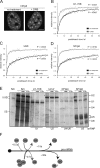The differential interaction of snRNPs with pre-mRNA reveals splicing kinetics in living cells
- PMID: 20921136
- PMCID: PMC2953428
- DOI: 10.1083/jcb.201004030
The differential interaction of snRNPs with pre-mRNA reveals splicing kinetics in living cells
Abstract
Precursor messenger RNA (pre-mRNA) splicing is catalyzed by the spliceosome, a large ribonucleoprotein (RNP) complex composed of five small nuclear RNP particles (snRNPs) and additional proteins. Using live cell imaging of GFP-tagged snRNP components expressed at endogenous levels, we examined how the spliceosome assembles in vivo. A comprehensive analysis of snRNP dynamics in the cell nucleus enabled us to determine snRNP diffusion throughout the nucleoplasm as well as the interaction rates of individual snRNPs with pre-mRNA. Core components of the spliceosome, U2 and U5 snRNPs, associated with pre-mRNA for 15-30 s, indicating that splicing is accomplished within this time period. Additionally, binding of U1 and U4/U6 snRNPs with pre-mRNA occurred within seconds, indicating that the interaction of individual snRNPs with pre-mRNA is distinct. These results are consistent with the predictions of the step-wise model of spliceosome assembly and provide an estimate on the rate of splicing in human cells.
Figures





Similar articles
-
Interaction of the human autoantigen p150 with splicing snRNPs.J Cell Sci. 1993 Jul;105 ( Pt 3):685-97. doi: 10.1242/jcs.105.3.685. J Cell Sci. 1993. PMID: 8408296
-
The nuclear cap-binding complex interacts with the U4/U6·U5 tri-snRNP and promotes spliceosome assembly in mammalian cells.RNA. 2013 Aug;19(8):1054-63. doi: 10.1261/rna.037069.112. Epub 2013 Jun 21. RNA. 2013. PMID: 23793891 Free PMC article.
-
Association of U2, U4, U5, and U6 small nuclear ribonucleoproteins in a spliceosome-type complex in absence of precursor RNA.Proc Natl Acad Sci U S A. 1988 Aug;85(15):5459-62. doi: 10.1073/pnas.85.15.5459. Proc Natl Acad Sci U S A. 1988. PMID: 2969592 Free PMC article.
-
Pre-mRNA splicing: the discovery of a new spliceosome doubles the challenge.Trends Biochem Sci. 1997 Apr;22(4):132-7. doi: 10.1016/s0968-0004(97)01018-9. Trends Biochem Sci. 1997. PMID: 9149533 Review.
-
The spliceosome.Bioessays. 1993 Sep;15(9):595-603. doi: 10.1002/bies.950150905. Bioessays. 1993. PMID: 8240312 Review.
Cited by
-
Nuclear LSm8 affects number of cytoplasmic processing bodies via controlling cellular distribution of Like-Sm proteins.Mol Biol Cell. 2012 Oct;23(19):3776-85. doi: 10.1091/mbc.E12-02-0085. Epub 2012 Aug 8. Mol Biol Cell. 2012. PMID: 22875987 Free PMC article.
-
Genetics and biochemistry remain essential in the structural era of the spliceosome.Methods. 2017 Aug 1;125:3-9. doi: 10.1016/j.ymeth.2017.01.006. Epub 2017 Jan 26. Methods. 2017. PMID: 28132896 Free PMC article. Review.
-
Post-transcriptional splicing can occur in a slow-moving zone around the gene.Elife. 2024 Apr 5;12:RP91357. doi: 10.7554/eLife.91357. Elife. 2024. PMID: 38577979 Free PMC article.
-
The transition in spliceosome assembly from complex E to complex A purges surplus U1 snRNPs from alternative splice sites.Nucleic Acids Res. 2012 Aug;40(14):6850-62. doi: 10.1093/nar/gks322. Epub 2012 Apr 13. Nucleic Acids Res. 2012. PMID: 22505580 Free PMC article.
-
Changes of Gene Expression in Euglena gracilis Obtained During the 29th DLR Parabolic Flight Campaign.Sci Rep. 2019 Oct 3;9(1):14260. doi: 10.1038/s41598-019-50611-4. Sci Rep. 2019. PMID: 31582787 Free PMC article.
References
-
- Behzadnia N., Golas M.M., Hartmuth K., Sander B., Kastner B., Deckert J., Dube P., Will C.L., Urlaub H., Stark H., Lührmann R. 2007. Composition and three-dimensional EM structure of double affinity-purified, human prespliceosomal A complexes. EMBO J. 26:1737–1748 10.1038/sj.emboj.7601631 - DOI - PMC - PubMed
Publication types
MeSH terms
Substances
LinkOut - more resources
Full Text Sources
Other Literature Sources

